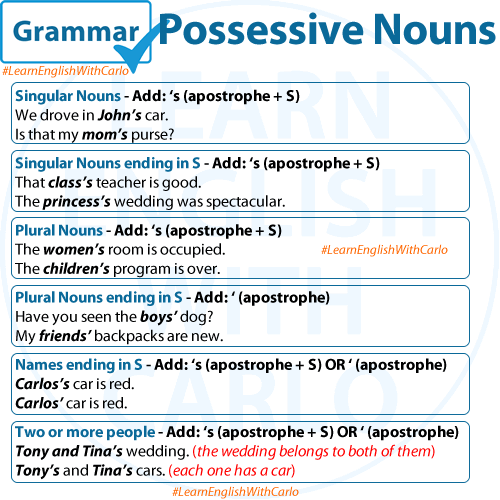Possessive nouns can seem tricky at first, but once you grasp the rules, you’ll find them easy to use. In this post, we’ll explore how to form possessive nouns in different contexts, ensuring that you can confidently show ownership in your writing.

1. Singular Nouns
For most singular nouns, showing possession is straightforward. Simply add an apostrophe followed by the letter “s” (’s).
Examples:
- We drove in John’s car.
- That isn’t the dog’s bed.
- Is that my mom’s purse?
This rule applies to any singular noun, regardless of what letter it ends with.
2. Singular Nouns Ending in S
When a singular noun ends in “s,” you still typically add ’s to show possession. However, in some cases, adding just the apostrophe (’) is also acceptable, especially in formal writing. Both forms are widely recognized, but consistency is key—stick to one style throughout your writing.
Examples:
- That class’s teacher is good.
- Her boss’s secretary is excellent.
- The princess’s wedding was spectacular.
Alternatively:
- The princess’ wedding was spectacular.
3. Plural Nouns
For plural nouns that do not end in “s,” you form the possessive by adding ’s.
Examples:
- He always corrects people’s mistakes.
- The women’s room is occupied.
- The children’s program is over.
Notice that “people,” “women,” and “children” are irregular plurals that do not end in “s,” so the possessive is formed in the same way as for singular nouns.
4. Plural Nouns Ending in S
For plural nouns that do end in “s,” you simply add an apostrophe (’) after the “s.”
Examples:
- Have you seen the boys’ dog?
- My friends’ backpacks are new.
- You don’t need your parents’ permission.
This rule helps to distinguish between the possessive form of singular nouns and plural nouns.
5. Names Ending in S
When it comes to names that end in “s,” you have two options. You can add either ’s or just the apostrophe (’). Both are correct, but again, be consistent.
Examples:
- Carlos’s car is red.
- Carlos’ car is red.
Whether you choose to add ’s or just the apostrophe may depend on your personal preference, the style guide you’re following, or the sound of the word when spoken aloud.
6. Possession Involving Two or More People
When two or more people share ownership of something, you add ’s (or ’ for plural nouns ending in “s”) to the last person’s name. If each person owns something separately, add ’s to each name.
Examples:
- Tony and Tina’s wedding. (The wedding belongs to both Tony and Tina.)
- Tony’s and Tina’s cars. (Tony has one car, and Tina has another.)
This distinction helps clarify whether the possession is joint or separate.
Final Thoughts
Mastering possessive nouns is essential for clear and precise writing. By following these simple rules, you can confidently form possessives in any context. Remember, the key to using possessive nouns correctly is understanding the relationship between the noun and what it owns. Practice these rules, and they’ll soon become second nature!
